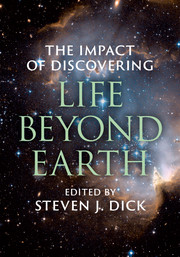Book contents
- Frontmatter
- Dedication
- Contents
- List of contributors
- Introduction: Astrobiology and society
- Part I Motivations and approaches: How do we frame the problems of discovery and impact?
- 1 Current approaches to finding life beyond Earth, and what happens if we do
- 2 The philosophy of astrobiology: The Copernican and Darwinian philosophical presuppositions
- 3 History, discovery, analogy: Three approaches to the impact of discovering life beyond Earth
- 4 A multidimensional impact model for the discovery of extraterrestrial life
- Part II Transcending anthropocentrism: How do we move beyond our own preconceptions of life, intelligence, and culture?
- Part III Philosophical, theological, and moral impact: How do we comprehend the cultural challenges raised by discovery?
- Part IV Practical considerations: how should society prepare for discovery – and non-discovery?
- Contributor biographies
- Index
- References
2 - The philosophy of astrobiology: The Copernican and Darwinian philosophical presuppositions
from Part I - Motivations and approaches: How do we frame the problems of discovery and impact?
Published online by Cambridge University Press: 05 November 2015
- Frontmatter
- Dedication
- Contents
- List of contributors
- Introduction: Astrobiology and society
- Part I Motivations and approaches: How do we frame the problems of discovery and impact?
- 1 Current approaches to finding life beyond Earth, and what happens if we do
- 2 The philosophy of astrobiology: The Copernican and Darwinian philosophical presuppositions
- 3 History, discovery, analogy: Three approaches to the impact of discovering life beyond Earth
- 4 A multidimensional impact model for the discovery of extraterrestrial life
- Part II Transcending anthropocentrism: How do we move beyond our own preconceptions of life, intelligence, and culture?
- Part III Philosophical, theological, and moral impact: How do we comprehend the cultural challenges raised by discovery?
- Part IV Practical considerations: how should society prepare for discovery – and non-discovery?
- Contributor biographies
- Index
- References
Summary
Contrary to common wisdom, science is not exclusively defined by its methods and theories, nor is it constituted only by substantiated empirical hypotheses. Rather, philosophical presuppositions are also a crucial part of the scientific endeavor. Astrobiology, like any scientific field that seeks to learn and understand nature, rests on such philosophical presuppositions. We do not experience nature as a clean slate, as the tabula rasa upheld by the seventeenth–eighteenth-century Empiricists. Philosophical presuppositions guiding science are general, universal claims about nature that transcend limited experience. For example, the notion that natural laws necessarily hold not only on our planet or in our galaxy but in the universe at large cannot be proved or disproved empirically. Nevertheless, it is on the basis of the universal applicability of natural laws that astrobiological research is conducted. Likewise, any other branch of the natural sciences could not function and advance without this principle. Furthermore, philosophical presuppositions express general guiding evaluations of reality that by definition are not open to observation or experience. The claim that nature was created and designed by an intelligent designer or the denial of this claim cannot be empirically settled. Yet, it is the notion that natural processes depend on natural causes and not on supernatural purposes which guides science.
Although the status of philosophical assumptions in science clearly differs from that of theoretical-empirical claims, these two elements are deeply connected. The interaction between the theoretical-empirical and the philosophical becomes apparent when science is examined historically. I argue that this interaction, shaped to a large extent by social and cultural factors, has resulted in the last few centuries in the establishment of the evolutionary naturalistic worldview. The major defining feature of this worldview is the rejection of supernatural teleology as necessary for the scientific study and understanding of nature.
Philosophical presuppositions of astrobiology
The natural sciences of today function within the framework of the naturalistic worldview. It is the robustness of this framework which provides validity also to branches of science that are still at the stage of establishing their fundamental data, notably the study of the origin of life on Earth and astrobiology. It has been claimed that the problem of the origin of life, yet unsolved, is the “soft underbelly of evolutionary biology” (Scott 1996).
- Type
- Chapter
- Information
- The Impact of Discovering Life beyond Earth , pp. 23 - 37Publisher: Cambridge University PressPrint publication year: 2015
References
- 2
- Cited by



